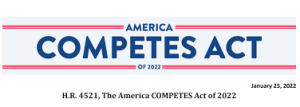28 Jan 2022 COMPETES Act, 2022

- The United States has unveiled the ambitious America Creating Opportunities for Manufacturing, Pre-Eminence in Technology and Economic Strength (COMPETES) Act, 2022 that seeks to open new avenues for talented individuals around the world with a new start-up visa.
- It aims to strengthen supply chains and reinvigorate the country’s economy in innovation to overtake China and the rest of the world in the coming decades.
Provision:
- US$52 billion to encourage semiconductor production in the US and US$45 billion for supply chain flexibility, grants and loans to improve manufacturing, among other programs.
- Financing to address social and economic inequality, climate change and immigration. For example, it waives the green card limit for STEM (science, technology, engineering, or math) PhDs and creates a new green card for entrepreneurs.
- A green card holder (permanent resident) is a person who has been granted the right to live and work in the United States on a permanent basis.
- This bill/bill releases US$600 million annually to build manufacturing facilities to reduce the United States’ reliance on solar components manufactured in Xinjiang, China.
- It creates a new category- ‘W’ of non-immigrants for entrepreneurs with an ownership interest in a start-up unit, essential employees of a start-up unit and their spouses and children.
Importance:
- This means that more opportunities will be available for Indian talent and skilled workers in America.
- Be aware that every year many Indians and Indian companies receive a substantial portion of H-1B ‘work permits’ issued in that year. With this new category Indian professionals are also likely to seize the opportunities that will be provided by the Act.
Work Visa:
- The IT revolution, the advent of the Internet and low-cost computers in developing countries like India, has led to the number of people willing to work at relatively low costs in the US, which is a great position for both employers and workers.
- The US administration issues a certain number of visas each year to fill vacancies for highly skilled low-cost workers in IT and other related fields.
- These visas allow companies outside the US to send employees to work at client sites.
Different types of Visa:
H1-B Visa:
- People seeking employment in the United States are required to obtain an H1-B visa. The H1-B visa is a visa granted to non-immigrant citizens seeking employment in the United States under sections 101(a) and 15(h) of the Immigration and Nationality Act.
- It allows US employers to temporarily employ foreign workers in specialty occupations.
H2-B Visa:
- The application form must be certified by the Labor Department to apply for such a visa. It is issued for temporary employment.
L-1 Visa:
- This is a non-immigrant visa under which companies can hire foreign workers in their subsidiaries or parent companies based in the US.
H-4 Visa:
- An H-4 visa is issued to dependent family members (spouse) of H1-B visa holders who wish to remain in the US during their stay with the H1-B visa holder. Under the H-4 visa, the main applicant is the holder of the H1-B visa.
- Family members such as spouses, children under the age of 21 qualify for H-4 visas and can apply at a US consulate in their home country.
J-1 Visa:
- This is for students on summer programs related to work-study.


No Comments